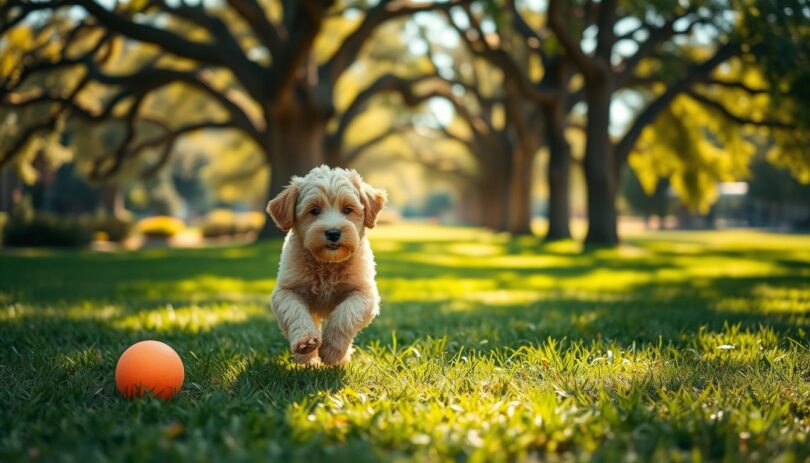Are you considering bringing a Mini Labradoodle into your family? These charming, hypoallergenic dogs have quickly become a favorite for many pet lovers. Their loving nature, intelligence, and adaptability make them an excellent choice for families and individuals alike.
Mini Labradoodles are known for their low-shedding coats, which are perfect for those with allergies. Their size, typically between 14-16 inches in height and weighing 10-30 pounds, makes them ideal for a variety of living situations, from apartments to larger homes. This guide is tailored for owners and potential adopters in the United States, offering expert advice on feeding, exercise, grooming, and more.
Whether you're a first-time dog owner or a seasoned pet parent, this comprehensive guide will provide you with the knowledge to give your Mini Labradoodle the best possible care. From training tips to health considerations, we've got you covered to ensure your furry friend leads a happy and healthy life.
Understanding the Mini Labradoodle Breed
Discovering the origins and unique traits of the Mini Labradoodle can help you better understand this beloved breed. Originating in Australia in the 1980s, Mini Labradoodles were first bred as guide dogs for individuals with allergies. This crossbreed combines the friendly nature of a Labrador Retriever with the intelligence and low-shedding coat of a Miniature Poodle.
History and Origins
The development of Mini Labradoodles began as an effort to create a hypoallergenic guide dog. By blending the loyal and outgoing Labrador with the intelligent Poodle, breeders achieved a dog that is both affectionate and easy to train.
Breed Characteristics and Temperament
Mini Labradoodles are known for their loving and adaptable nature, making them an excellent fit for families and various lifestyles. Their weight typically ranges from 10 to 30 pounds, and they usually stand between 14 to 16 inches tall. This size, combined with their intelligence, makes them a popular choice for many households.
These dogs thrive in both apartments and larger homes, provided they receive adequate exercise and attention. Their temperament is highly social, allowing them to bond well with children and other pets. Training is often straightforward due to their eagerness to please, making them a great choice for first-time dog owners.
Mini Labradoodle Appearance and Size Guides
Understanding the size and weight of your Mini Labradoodle is essential for providing the right care. These dogs come in various sizes, making them suitable for different lifestyles and living spaces.
Size Range and Weight Insights
On average, Mini Labradoodles stand between 14 to 16 inches tall and weigh from 10 to 30 pounds. Their compact size makes them a great fit for both apartments and larger homes. The weight of your dog can influence their exercise needs and diet, so it's important to monitor these aspects closely.
Teacup and Toy Variations
While the standard Mini Labradoodle is a popular choice, some breeders offer Teacup and Toy variations. Teacup Labradoodles weigh less than 15 pounds, while Toy Labradoodles typically range from 15 to 20 pounds. These smaller sizes are ideal for families with limited space or those who prefer a more portable pet.
The size of your Labradoodle puppy is also influenced by its parent breeds. For example, an F1B Mini Labradoodle, which is 75% Poodle and 25% Labrador, may be smaller due to the Poodle's influence. This genetic mix can also affect their coat type and shedding patterns.
When choosing the right Labradoodle puppy for your lifestyle, consider your available space and daily routine. Smaller dogs like the Teacup or Toy variations require less exercise but still need regular activity to stay healthy. For more information on caring for these smaller breeds, you can visit this guide or explore tips on mini Goldendoodle care.
Unique Coat Types and Color Varieties
Mini Labradoodles boast a variety of coat types and colors, making each dog unique. Their coats can be straight, wavy, or curly, each with distinct characteristics. Additionally, they come in a range of appealing colors, from black and brown to white and apricot.
Exploring Coat Textures: Straight, Wavy, and Curly
Straight coats are smooth and lie flat, requiring less grooming. Wavy coats have a subtle wave, offering a balanced look and moderate shedding. Curly coats are tight and non-shedding, ideal for those with allergies but needing regular grooming.
Popular Coat Colors Explained
Black, brown, white, and apricot are common colors. Black coats are sleek, while brown offers warmth. White coats are crisp, and apricot adds a golden touch. These colors enhance the dog's appearance and suit various environments.
Mini Labradoodle Temperament and Family Compatibility
Known for their gentle and affectionate nature, Mini Labradoodles make wonderful family pets. Their adaptable temperament allows them to thrive in various living situations, from bustling homes to quieter environments.
These dogs typically weigh between 10 to 30 pounds and stand 14 to 16 inches tall, making them a great fit for families with children. Their size and calm demeanor ensure they can play safely with kids, while their intelligence makes them easy to train.
Social Behavior with Kids and Pets
Mini Labradoodles are highly social and get along well with other pets, especially if socialized early. They enjoy interacting with cats, rabbits, and even birds, creating a harmonious multi-pet household.
For parents concerned about exercise needs, these dogs require about 30 to 60 minutes of activity daily. This can include walks, playtime, or even indoor games, ensuring they stay happy and healthy.
Essential Training and Socialization Techniques
Training and socializing your dog are key to raising a well-behaved and confident companion. These steps ensure your labradoodle puppy grows into a well-adjusted adult.
Basic Command Training Tips
Start with simple commands like “Sit” and “Stay.” Use positive reinforcement with treats and praise. Keep sessions short, around 5-10 minutes, to maintain focus. Consistency is crucial for effective learning.
As your puppy progresses, introduce more complex commands. Be patient and reward good behavior. This approach helps build trust and strengthens your bond with your dog.
Effective Socialization Strategies
Socialization is vital during the critical window of 3 to 16 weeks. Introduce your labradoodle puppy to various environments, people, and experiences. This helps prevent anxiety and aggression later in life.
Exposure to new sights, sounds, and smells is essential. Consider enrolling in puppy classes or visiting dog-friendly areas. For more tips, visit this guide on effective training techniques.
Remember, consistency and positive reinforcement are key to successful training. With patience and dedication, your labradoodle will become a well-behaved and loyal companion.
Proper Diet, Exercise, and Nutrition
Ensuring your dog maintains a healthy weight and lifestyle is crucial for their overall well-being. A balanced diet and regular exercise are key to supporting their growth and preventing potential health issues.
Feeding Guidelines for Every Life Stage
Puppies require a diet rich in protein to support muscle growth, typically needing three to four meals a day. As they mature, adults should transition to a diet that aligns with their exercise routine to prevent weight gain.
Seniors benefit from lower-calorie food to avoid weight gain due to slower metabolism. Monitoring weight and adjusting portions is essential to prevent obesity and ensure they receive the necessary nutrients.
- Puppies: High-protein diet, 3-4 meals/day
- Adults: Tailored intake based on exercise
- Seniors: Lower-calorie food, added fiber
Combine high-quality kibble with fresh vegetables for balanced nutrition. Ensure access to clean water and consider wet food for hydration. Avoid overfeeding treats to maintain calorie balance.
Health Concerns and Lifespan Considerations
Understanding the health needs of your dog is crucial for ensuring a long and happy life. Mini Labradoodles generally live between 12 to 14 years, but their health can be influenced by diet, size, and family care.
Common Health Issues to Watch For
Like many breeds, Mini Labradoodles can face certain health challenges. Hip dysplasia and ear infections are common, while food allergies can also arise. Regular vet visits and a balanced diet play a significant role in preventing these issues.
Preventative Care and Vet Visits
Preventative care is key to extending your dog's lifespan. Regular check-ups can help catch issues early, potentially adding 1 to 2 years to their life. Monitoring for signs like weight gain or vision problems is essential for timely intervention.
A healthy weight and proper care contribute to a fulfilling life for your dog. By staying informed and proactive, you can ensure your family's peace of mind and your dog's well-being.
Mini Labradoodle – Understanding Generations and Growth
When choosing a labradoodle puppy, understanding the differences between generations can help you make an informed decision. Each generation, such as F1, F1B, and F2, offers unique traits influenced by their parent breeds.
Differences Between F1, F1B, and F2 Generations
F1 labradoodles are a 50-50 mix of Labrador Retriever and Poodle, often weighing between 15 to 30 pounds. They typically stand 14 to 16 inches tall and require moderate exercise. F1B labradoodles, combining an F1 with a Poodle, weigh around 10 to 25 pounds and are 13 to 15 inches tall, making them ideal for smaller spaces and those with allergies due to their low-shedding coats.
F2 labradoodles, resulting from breeding two F1s, usually weigh between 15 to 30 pounds and stand 14 to 16 inches tall. They offer a balance of traits from both parent breeds. These generations vary in size, coat type, and shedding levels, with F1Bs often having the most consistent low-shedding coats.
As your labradoodle puppy grows, their weight and size will progress steadily. Puppies typically double their birth weight in the first week and reach half their adult weight by four months. By six months, they are usually three-quarters of their adult size. Regular exercise tailored to their age is crucial, with puppies needing shorter, more frequent sessions and adults requiring at least 30 minutes of activity daily.
Age plays a significant role in growth rates. Labradoodles typically reach 75% of their adult height by six months and their full height by 12 to 18 months. Monitoring their weight and adjusting exercise routines can help maintain a healthy lifestyle. Understanding these growth patterns ensures you provide the best care for your labradoodle, whether they are a playful puppy or a mature adult.
Grooming and Maintenance Essentials
Grooming is a crucial part of caring for your dog, especially for breeds with unique coats. Regular grooming helps maintain their appearance and overall health.
Coat Care and Regular Grooming Routines
A regular grooming schedule is essential for your dog's well-being. This includes daily brushing, occasional bathing, and professional trimming every 4-6 weeks.
The type of coat your dog has will influence how often you need to groom them. For example, dogs with curly coats may need more frequent grooming than those with straight coats.
Here are some practical tips to keep your dog's coat healthy and mat-free:
- Brush your dog daily, paying special attention to areas where mats tend to form.
- Bathe your dog as needed, but avoid over-bathing to prevent dry skin.
- Use a conditioner to keep their coat soft and manageable.
When choosing grooming products, consider your dog's size and weight. For example, a smaller dog may require a different type of shampoo than a larger dog.
There are various grooming options available, from doing it yourself at home to taking your dog to a professional groomer. Consider what works best for you and your dog.
Proper grooming not only keeps your dog looking their best but also contributes to their comfort and health. Regular grooming can help prevent skin issues and keep their coat in great condition.
Wrapping Up the Ultimate Mini Labradoodle Care Guide
Bringing a labradoodle puppy into your family is a decision that requires careful thought and preparation. As an owner, understanding the unique needs of your dog, from training to nutrition and grooming, is essential for a fulfilling pet-parent relationship. Whether you're considering a labradoodle puppy for your family or already have one, it's important to focus on their size, exercise needs, and diet to ensure long-term health.
Choosing the right generation of labradoodle, such as F1 or F1B, can make a significant difference in their temperament and care requirements. Regular vet visits and preventative care strategies are crucial for maintaining your dog's well-being and addressing any health concerns early. If you have lingering questions about their lifestyle or daily routines, remember that consistency and patience are key to raising a happy and healthy labradoodle.
In conclusion, with the right care and attention, your labradoodle can thrive as a loving and loyal companion. For further reading and tips, explore trusted pet care resources or guides tailored to your dog's specific needs.
FAQ
What is the average weight of a Mini Labradoodle?
The average weight of a Mini Labradoodle typically ranges between 15 to 30 pounds, depending on its lineage and generation.
How do I determine the right diet for my Mini Labradoodle puppy?
Consult your veterinarian to create a balanced diet plan tailored to your puppy's age, size, and activity level. High-quality dog food with essential nutrients is recommended.
Are Mini Labradoodles suitable for families with small children?
Yes, Mini Labradoodles are generally excellent family dogs. They are friendly, gentle, and social, making them a great fit for families with kids.
How much exercise does a Mini Labradoodle need daily?
Mini Labradoodles require moderate exercise, such as daily walks and playtime, totaling about 30-45 minutes. They thrive on mental and physical stimulation.










Leave a Comment